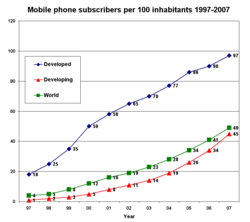
Main article:
History of mobile phones In 1908, U.S. Patent 887,357 for a wireless telephone was issued in to Nathan B. Stubblefield of Murray, Kentucky. He applied this patent to "cave radio" telephones and not directly to cellular telephony as the term is currently understood.[4] Cells for mobile phone base stations were invented in 1947 by Bell Labs engineers at AT&T and further developed by Bell Labs during the 1960s. Radiophones have a long and varied history going back to Reginald Fessenden's invention and shore-to-ship demonstration of radio telephony, through the Second World War with military use of radio telephony links and civil services in the 1950s, while hand-held cellular radio devices have been available since 1973. A patent for the first wireless phone as we know today was issued in US Patent Number 3,449,750 to George Sweigert of Euclid, Ohio on June 10, 1969.
In 1945, the zero generation (0G) of mobile telephones was introduced. Like other technologies of the time, it involved a single, powerful base station covering a wide area, and each telephone would effectively monopolize a channel over that whole area while in use. The concepts of frequency reuse and handoff, as well as a number of other concepts that formed the basis of modern cell phone technology, are first described in U.S. Patent 4,152,647, issued May 1, 1979 to Charles A. Gladden and Martin H. Parelman, both of Las Vegas, Nevada and assigned by them to the United States Government.
This is the first embodiment of all the concepts that formed the basis of the next major step in mobile telephony, the Analog cellular telephone. Concepts covered in this patent (cited in at least 34 other patents) also were later extended to several satellite communication systems. Later updating of the cellular system to a digital system credits this patent.
Martin Cooper, a Motorola researcher and executive is widely considered to be the inventor of the first practical mobile phone for hand-held use in a non-vehicle setting. Cooper is the first inventor named on "Radio telephone system" filed on October 17, 1973 with the US Patent Office and later issued as US Patent 3,906,166;[5] other named contributors on the patent included Cooper's boss, John F. Mitchell, Motorola's chief of portable communication products, who successfully pushed Motorola to develop wireless communication products that would be small enough to use outside the home, office or automobile and participated in the design of the cellular phone.[6][7] Using a modern, if somewhat heavy portable handset, Cooper made the first call on a hand-held mobile phone on April 3, 1973 to a rival, Dr. Joel S. Engel of Bell Labs.[8]
The first commercial citywide cellular network was launched in Japan by NTT in 1979. Fully automatic cellular networks were first introduced in the early to mid 1980s (the 1G generation). The Nordic Mobile Telephone (NMT) system went online in Denmark, Finland, Norway and Sweden in 1981.[9]














